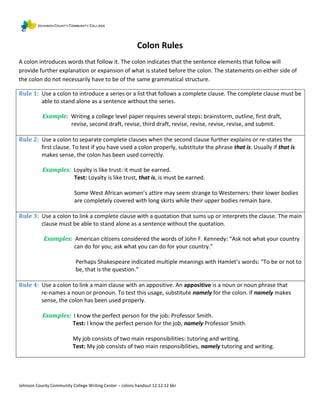Colons
- 1. Johnson County Community College Writing Center – colons handout 12.12.12 bkr Colon Rules A colon introduces words that follow it. The colon indicates that the sentence elements that follow will provide further explanation or expansion of what is stated before the colon. The statements on either side of the colon do not necessarily have to be of the same grammatical structure. Rule 1: Use a colon to introduce a series or a list that follows a complete clause. The complete clause must be able to stand alone as a sentence without the series. Example: Writing a college level paper requires several steps: brainstorm, outline, first draft, revise, second draft, revise, third draft, revise, revise, revise, revise, and submit. Rule 2: Use a colon to separate complete clauses when the second clause further explains or re-states the first clause. To test if you have used a colon properly, substitute the phrase that is. Usually if that is makes sense, the colon has been used correctly. Examples: Loyalty is like trust: it must be earned. Test: Loyalty is like trust, that is, is must be earned. Some West African women’s attire may seem strange to Westerners: their lower bodies are completely covered with long skirts while their upper bodies remain bare. Rule 3: Use a colon to link a complete clause with a quotation that sums up or interprets the clause. The main clause must be able to stand alone as a sentence without the quotation. Examples: American citizens considered the words of John F. Kennedy: “Ask not what your country can do for you; ask what you can do for your country.” Perhaps Shakespeare indicated multiple meanings with Hamlet’s words: “To be or not to be, that is the question.” Rule 4: Use a colon to link a main clause with an appositive. An appositive is a noun or noun phrase that re-names a noun or pronoun. To test this usage, substitute namely for the colon. If namely makes sense, the colon has been used properly. Examples: I know the perfect person for the job: Professor Smith. Test: I know the perfect person for the job, namely Professor Smith. My job consists of two main responsibilities: tutoring and writing. Test: My job consists of two main responsibilities, namely tutoring and writing.
- 2. Johnson County Community College Writing Center – colons handout 12.12.12 bkr The following rules address common errors that writers make with colons. Please note that all examples given are what NOT to do with colons. Rule 5: DO NOT use a colon between a verb and its object or complement. Remember, a colon must be preceded by a complete sentence. Examples: Some basic courses to take are: Composition 1, Composition 2, College Algebra, and Public Speaking. (incorrect) Important components of your grade are: attendance, homework assignments, papers, and exams. (incorrect) Rule 6: DO NOT use a colon between a preposition and its object. Examples: Each candidate’s qualifications must consist of: integrity, diligence, and experience. (incorrect) The materials for the engineering project were supplied by: Boeing, Cessna, and Lear. (incorrect) Rule 7: DO NOT use a colon after such as, including, or for example. Examples: Of paramount importance in the divorce dilemma is the breakdown of communication including: confict resolution, over-commitment, and fatigue . (incorrect) Several tools are available to improve communication in marriage such as: counseling, classes, and good books. (incorrect) Methods of good communication between spouses can be practiced, for example: active listening, writing out feelings, and participating in mutually enjoyable activities. (incorrect) These are the basic colon rules; for more complex rules, please see Writing Center staff or several handbooks available in the JCCC Writing Center. For exercises to practice your colon skills, please see Writing Center staff.

